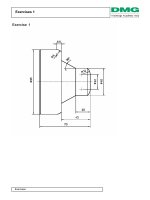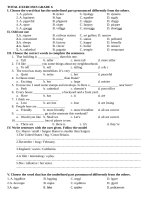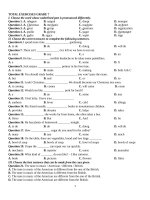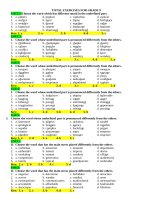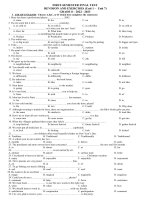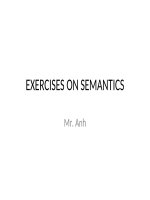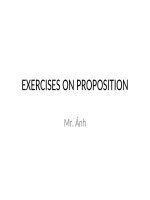EXERCISES LEXICOLOGY
Bạn đang xem bản rút gọn của tài liệu. Xem và tải ngay bản đầy đủ của tài liệu tại đây (123.09 KB, 15 trang )
I. FIND OUT THE ORIGINS AND MEANING OF THE FOLLOWING
ROOTS
1. AGR
2. ANIMA
3. ASTER
4. AUTO
5. BENE
6. BIO
7. BREV
8. CAPT
9. CARN
10.
CEDE,CESS
11.
CIDE
12.
CIV
13.
CORP
14.
CYCLE
15.
DEMO
16.
DOMIN
17.
GAM(Y)
18.
HOMO
19.
MANU
20.
PORT
II. FIND OUT THE MEANING OF THE FOLLOWING PREFIXES
1. A,AB
2. ANTE
3. BI
4. CO, COL, COM, CON, COR
5. CONTRA
6. DES
7. DEC
8. DIS
9. EM, EN
10.
EX
11.
EXTRA
12.
IL,IM,IN
13.
INTER
14.
MONO,UNI
15.
POLY
16.
POST
17.
PRE
18.
RE
19.
SEMI,HEMI,DEMI
20.
SUB
WORD STRUCTURE AND WORD FORMATION
EXERCISE 1
Add the correct ending (ar , ant , ary, ate , er , eer …)
1. solicit
3. Moscow
2. London
4. tobacco
1
5. motor
13.
shire
6. war
14.
potent
7. profit
15.
auction
8. heir
16.
practice
9. diet
17.
debt
10.
physics
18.
appoint
11.
refer
19.
visit
12.
defend
20.
read
EXERCISE 2
Say the part of speech of the word and its derivative in each of the following pairs:
1. break
breakage
2. desire
desirable
3. conspire
conspiracy
4. rehearse
rehearsal
5. ideal
idealize
6. false
falsify
7. plenty
plenteous
8. doubt
doubtful
9. mouth
mouthful
10.
sing
singer
11.
familiarize
familiarization
12.
passion
passionate
13.
host
hostess
14.
gloom
gloomy
15.
day
daily
16.
prohibit
prohibition
17.
excel
excellent
18.
friend
friendly
19.
create
creature
20.
manage
manager
EXERCISE 3
Add derivational suffix to each of these words which already end in a derivational
suffix
1. reasonable
6. purify
2. formal
7. inflection
3. socialist
8. personify
4. comprehensible
9. careless
5. organize
10.
effective
11.
12.
EXERCISE 4
13.
Combine the bases with the derivational suffixes listed. Make as many
nouns as you can.
14.
1. happy
2. friend
3. girl
4. compose
5. shrink
6. active
2
7. supreme
8. true
9. pagan
10.
discover
a. –age
b. –y
c. –hood
d. –acy
e. –ism
f. –ity
g. –ment
h. –ition
i. –ness
j. –th
k. –ance
l. –ship
11.
EXERCISE 5
12.
Add derivational suffix to each of these words which already end in a
derivational suffix
1. reasonable
2. formal
3. socialist
4. comprehensible
5. organize
6. purify
7. inflection
8. personify
9. careless
13.
10. personify
14.
15.
EXERCISE 6 : In these words the root is italicized . After each word write the
number of suffixes it contains:
16.
17.
1. organists
18.
2. personalities
19.
3. flirtatiously
20.
4. atomizers
21.
5. friendliest
22.
6. contradictorily
23.
7. trusteeship
24.
8. greasier
25.
9. countrified
26.
10. responsibilities
27.
28.
EXERCISE 7:
29.
Each group contains a root and suffixes . Make it into a word. In each case. see
if more than one order of suffixes is possible.
30.
1. –ed. live, -en
31.
2.-ing , -ate, termin
3
32.
33.
34.
35.
3. province. –s. –ism . -al
4. –ly, -some, grue
5. –ity, work, -able
6. –er, -s, mor, -al, -ize
36.
37.
COMPOUND
38.
EXERCISES
39.
40. 1. Distinguish between compounds and free word groups basing yourself on the
criteria discussed in the lecture:
41.
- The beautiful dancing girl is a dancing girl.
42.
- The White House is a white house but no other white house can be the
White House.
43.
- On the red tape there is a lot of information about the government
offices typical of red tape.
44.
- A blackleg is not a person with a black leg.
- “ She bought a lot of things : beef, cabbages, milk, bread and butter”. “ – Yes, she
is very fond of bread and butter “.
45.
46.
2. Classify the compounds below according to their meanings :
47.
boyfriend , easy – going , (to) machinewash , (to) give – in , long – legged ,
speedometer , table tennis , lady killer , whole – heartedly , happy – go – lucky.
48.
49.
3. Explain the joke below :
50.
First woman : - That doctor’s quite a lady – killer.
51.
Second woman (not very attentive) : - My God ! I’d better go and see
another.
52.
4. In the dialogue below, the Vietnamese friend made a mistake, therefore the
Australian friend did not understand him and was offended. What is that mistake? Can
you imagine the situation?
53.
Man : - John , there’s a bluebottle on the table.
54.
John : - Yes , I know . Why?
55.
Man : - Bluebottles are dirty , you know.
56.
John : - Nonsense , I’ve washed it carefully.
57.
58.
5. Explain the formation of the following compound word
59.
newspaper, football, moonstruck, turncoat
60.
Noun + noun = compound noun
61.
6. Say the process (inflection, derivation, composition) by which of the
words listed below are built up:
a. swims
b. football
c. director
d. pleasure
e. salesman
f. simplest
g. artistic
4
h. collector
i. mountainous
j. covering
62.
63.
64.
65.
66.
67.
68.
69.
70.
71.
72.
73.
7. Mark C (coordinate) , S (subordinate) before the following.
a. homesick
b. bookshop
c. well-known
d. dog-fish
e. landlady
f. dark blue
g. she-goat
h. teacup
i. blackbird
j. awestruck
75.
74.
SHORTENING
76.
EXERCISE 1: Give the originals from which these clipped words are
built up
1. A – bomb
21. memo
41. 41. caf
2. A – level
22. shun
42. 42. hanky
3. appro
23. brandy
43. sergt
4. diff
24. fax
44. Japs
5. fem
25. gym
45. teeny
6. info
26. petrol
46. doc
7. lang
27. psych
47. dub
8. lux
28. sport
48. extra
9. math
29. cab
49. nightie
10. O – level
30. pike
50. van
11. pop
31. bus
51. zoo
12. ref
32. cello
52. fridge
13. ad
33. coon
53. tec
14. gas
34. demob
54. fancy
15. exam
35. coke
55. specs
16. prof
36. mac
56. pram
17. frat
37. ref
57. movie
18. photo
38. eco
58. flu
19. gin
39. vet
59. story
20. curio
40. co-ed
60.
Vday
43. EXERCISE 2 : Pronounce these words and give their original
1. UNESCO
7. GATT
2. radar
8. NATO
3. CARE
9. SALT
4. AIDS
10. UFO
5. UNICEF
11. UNO
6. BASIC
12. VAT
5
13. WHO
27. EEC
14. WAC
28. CMEA
15. AWOL
29. CENTO
16. NIC
30. CSE
17. MIA
31. FAO
18. POW
32. GNP
19. H – of – L
33. GPO
20. H – of - C
34. PEN
21. ASEAN
35. VIP
22. CIA
36. CAT
23. FBI
37. PLO
24. GMT
38. GI
25. SNC
39. GNP
26. UNDP
40. NHS
41.
42. EXERCISE 3 : Give the blends that result from these words
1. smoke + fog
=
2. telegraph + broadcast
=
3. motorist + hotel
=
4. escalate + elevator =
5. automobike + omnibus
=
6. newspaper + boy
=
7. traffic + indicator
=
8. American + Indian =
9. breath + analyser
=
10.
medical + care
=
43.
Give the originals of these words
1. transceiver
2. chunnel
3. telex
4. positron
5. stagflation
44. EXERCISE 4 : Give the originals to the following back formation words
1. bootleg
2. resurrect
3. baby – sit
4. escalate
5. advance – register
6. laze
7. supervise
8. separate
9. edite
10.
baby – mind
11.
gate – crash
12.
tape – recorder
13.
enthuse
14.
formate
15.
window – shop
16.
troubleshoot
6
17.
18.
19.
20.
bestsell
brainwash
witchhunt
beg
45.
46. HOMONYM
47. EXERCISE 1 : Comment on the following homonyms and polysemantic
words.
48.
1. The village , was situated along the both banks on a small river . The boat
could not pass here because of the sand banks . He invested money into two different
banks.
49.
2. Don’t spit in the well , you may need its water.
50.
- All is well that ends well.
3. She is a good match for you.
51.
The match ended in a draw.
52.
4. The voting was done by the show of hands . The hands of the clock showed
half past ten. There were 12 hands employed at this farm.
53. EXERCISE 2 : Comment the type of homonyms
54.
- wait – weight
55.
- sole - soul
56.
- rose ( past ) – rose ( n )
57.
- bear ( n ) – bear ( n ) – bare ( adj )
58.
- read ( adj ) – read ( n )
59.
- firm ( n ) – firm ( adj )
60.
- match ( n ) – match ( n ) – match ( n )
61.
- right ( n ) – right ( adj )
62.
- thought ( n ) – thought ( past )
63.
64. SYNONYM – ANTONYM
65. EXERCISE 1: Find the synonymic dominant
66.
- keen - able
- clever - gifted - intelligent
67.
- hide - conceal - disguise - mask
68.
- poor - impoverished - needy - penniless
69.
- complain - grumble - whine - growl
70.
- valour - gallantry - courage - fortitude
71.
- cackle - giggle - laugh - chuckle
72.
- scent - odour - smell - fragrance - aroma
73.
- agree - consent - assent - accede
74.
EXERCISE 2 : Comment on the types of synonyms
75.
- accident - disaster - misfortune - calamity catastrophe
76.
- biscuit - cookie
77.
- pair - couple
78.
- merry - gay - jolly
79.
- glitter - spark - clear - glare - shine
80.
- much - many
81.
- enemy - foe
82.
- cry - weep - scream - shriek
83.
- father - dad
84.
- to answer - to reply
7
85.
- house - dwelling - residence
86.
- to continue - to go on
87.
- to eat - to gobble - to peck - to wolf
88.
- policeman - bobby - officer - cop
89.
- hooligan - hoodlum
90.
- petrol - gasoline - gas
91.
- shop - store - supermarket
92.
- strike - stay- out - work - out
93.
- crazy - queer - mad
94.
- ill - sick
95.
- bicycle - bike
96.
- car - automobile
97.
- gather - collect - assemble
98.
- fright - fear - terror - dread
99.
- discharge - dismiss - sack - fire - lay off
100.
- to reduce - to axe - to cut back
101.
- chap - lad - fellow
102.
- talk - chatter - jabber - babble
103.
- to end - to finish - to complete
104.
105.
EXERCISE 3 : Give antonyms to the following words ( derivational and
antonyms proper )
106.
107.
happy- drunkard
unhappy
- selfish-generous
- greed
- literary
- responsible
- moral
- loyal
- balance-unbalance
- to lead
- to charge
- firm
- to promote
- to load
- to increase -to decrease
- helpless-helpful
- to mobilize
- dull pupil
- private-public
- dull book
- to trust-unbelieve
- attentive
- false- true
- dry voice
good-looking-urgly
108.
109.
AMERICAN ENGLISH
110.
EXERCISE 1 : State which words out of two mostly used in AE and which is
general English words
111.
billfold
notecase
112.
biscuit
cookie
113.
gasoline
petrol
114.
beach
seaside
115.
line
queue
116.
luggage
baggage
117.
store
shop
118.
can
tin
8
119.
120.
121.
122.
123.
124.
lift
elevator
schedule
time-table
picture
movie
bank-note
bill
truck
lorry
EXERCISE 2. There are some words used in AE. Find out the words used in
BA
125.
126.
127.
128.
129.
130.
131.
132.
133.
134.
135.
136.
149.
150.
151.
152.
153.
154.
155.
156.
157.
158.
159.
160.
161.
162.
163.
164.
165.
166.
167.
168.
169.
170.
171.
172.
173.
174.
175.
9
areplane
assignment
bar
bathroom sink
bureau
calender book
call
cart
check
check room
chips
closet
tap
137.
138.
139.
140.
141.
142.
143.
144.
145.
146.
147.
148.
cooler
corn
couch
fabric
figure
fire department
freeway
garbage
grade school
grade
housewares
inquire
bank-note
1. BE: I shall tell you later
AE:
2. BE: Shall I drin it now?
AE:
3. BE:Have you ever gone to Dalat?
AE:
4. BE:It seems like a long time.
AE:
5. BE:Go and fix it now.
AE:
6. BE:Can I come and have a cup of coffee with you?
AE:
7. BE:The dog wants to go out.
AE:
8.BE: talk to somebody.
AE:
9.BE: prevent sth becoming (doing)
AE:
10.BE: to be in hospital
AE:
11.BE: to be at university.
AE:
12.BE: to be in class
AE:
176.
AE
177.
178.
179.
180.
181.
182.
183.
184.
185.
186.
187.
188.
189.
203.
204.
205.
206.
207.
208.
209.
210.
211.
EXERCISE 3: Comment on the meanings of the following words in BE and
1. car:
2. lunch:
3. sick:
4. crash:
5. apartment:
6. to guess:
7. fall:
190.
191.
192.
193.
194.
195.
196.
197.
198.
199.
200.
201.
202.
8. dumb:
9. market:
10. nervy:
11. pavement:
12. pants:
13. homely:
QUESTIONS
1. All morphemes are subdivided into two large classes: roots and affixes
2. Root words are words which have only a root morpheme in its structure.
3. Derived words are words which consist of a root and an affix and are
4.
5.
6.
7.
8.
9.
10.
10
produced by the process of word-building known as affixation.
Compound words are produced by the word-building process called
composition.
The process of affixation consists in joining a new word by adding an affix or
several affixes to some root morphemes
Conversion is an affixless way of word-building or even affixless derivation.
Conversion is a type of word-building in which new words are formed
without affixes.
In neutral compounds the process of compounding is realized without any
linking element, by a mere juxtaposition.
How many subtypes of neutral compounds are there in English language?
How are they classified?
Three subtypes of neutral compounds depending on the structure of the
constituent stems.
Simple neutral compounds: affixless stems. Ex: schoolboy
Derivational compounds: affixes in their structure. Ex: goalkeeper
Contracted compounds: a shortened stem in their structure. Ex: H-bag
Compounds which have affixes in their structure are called derived or
derivational compounds.
11. Compounding, or composition is the process of putting two words together to
form a third.
12. The compounds whose meanings do not correspond to the separate meanings
of their constituent parts are called idiomatic compounds.
13. The compounds whose meanings can really be described as the sum of their
constituent meanings are called non- idiomatic compounds.
14. In idiomatic compounds, the process of deducing the meaning of the whole
from the meanings of the constituents is impossible.
15.
In a compound, the second free morpheme usually receives the
secondary stress and is marked for number.
16. Clipping is a type of shortening in which a new word is made from a syllable
of the original word.
17. Blending is a special type of shortening in which parts of words merge into
one to form a new word.
18. Abbreviation is the second way of shortening which makes a new word from
the initial letters of a group.
19. The branch of linguistics which specializes in the study of meaning is called
semantics.
20. The denotative components express the conceptual content of a word.
21. One of the most important “drawbacks” of polysemantic words is that there is
sometimes a chance of misunderstanding when a word is used in a certain
meaning but accepted by listener or reader in another.
22. Meaning is the most important characteristics of the word.
23. Back formation is the type of word-building in which a verb was produced
from a noun by subtraction instead of a noun made from a verb by affixation.
24. Homonyms are words which are identical in sound and spelling, or, at least,
in one of these aspects, but different in their meaning.
25. Homonyms which are the same in sound and spelling are traditionally termed
homonyms proper.
26. Homographs are words which are the same in spelling but different in sound.
27. Homophones are words which are the same in sound but different in spelling.
28. Homonyms which are the same in sound and spelling but refer to different
categories of parts of speech, are called lexico-grammatical homonyms.
212. Ex: comb (n) – to comb (v), make (n) – to make (v)
29. Full homonyms are words which represent the same category of parts of
speech and have the same paradigm.
30. Simple lexico-grammatical partial homonyms are words which belong to the
same category of parts of speech. Their paradigms have one identical form,
but it is never the same form.
31. Complex lexico-grammatical partial homonyms are words of different
categories of parts of speech which have one identical form in their
paradigms.
11
32. Partial lexical homonyms are words of the same category of parts of speech
33.
34.
35.
36.
37.
38.
39.
40.
41.
42.
43.
44.
45.
46.
47.
48.
12
which are identical only in their corresponding forms.
Synonym are words belonging to the same part of speech and possessing one
or more identical or nearly identical denotational meaning, interchangeable in
some contexts.
According to semantic criterion, synonyms are defined as words with the
same denotation, or the same denotative component, but differing in
connotations, or in connotative components.
According to notional criterion, synonyms are defined as words of the same
category of parts of speech conveying the same notion but differing either in
shades of meaning or in stylistic characteristics.
According to criterion of interchangeability, synonyms are defined as words
which are interchangeable at least in some contexts without any considerable
alteration in denotational meaning.
Antonyms are words of opposite/contrasting meanings and of the same part of
speech.
Root word antonyms are words which are completely different in sound and
form.
Derivational antonyms are words which are formed by derivation.
There are two major criteria for distinguishing between phraseological units
and free word-groups: semantic and structural.
A phraseological unit is a stable word-group characterized by a completely or
partially transferred meaning.
According to structural criterion, phraseological units have three restrictions:
restriction in substitution, restriction in introducing any additional
components and grammatical invariability.
Phraseological combination are word-groups with a partially changed
meaning. The meaning of the unit can be easily deduced from the meanings
of its constituents.
Phraseological unities are word-groups with a completely changed meaning,
that is, the meaning of the unit does not correspond to the meanings of its
constituent parts.
Phraseological fusions are word-groups with a completely changed meaning
but , in contrast to the unities ,their meaning can not be deduced from the
meanings of the constituent parts.
A root is a form which is not further analyzable, either in terms of
derivational or inflectional morphology.
A stem is the part of word-form which remains when all inflectional affixes
have been removed.
Lexicology deals not only with simple words in all their aspects, but also with
complex and compound words, the meaningful units of language.
49. Derivational morphemes carry both lexical and grammatical meaning. They
are used to create new words and are study in lexicology.
50. Inflectional morpheme is also called inflection or ending. They are used to
create different forms of the same word
(boy-boys). They carry the
grammatical meaning and are studied in grammar.
51. Affixes are bound morphemes which never occur on their own; they have
semantic holes in their structure and so must be joined to other morphemes to
fill them.
52. Affixation is the morphological process of deriving a new word by adding an
affix, namely a bound morpheme, to a root or base.
53. Prefixation is the morphological process of forming a new word by attaching
a bound morpheme to the front of the free morpheme.
54. Suffixation is the morphological process of forming a new word by attaching
a bound morpheme to the end of the free morpheme.
55. Inflectional affixes are endings which add extra information to the root but
preserve the word class.
56. A POLYSEMOUS WORD is a word that has two or more meanings and they
are closely related.
57. SYNONYMY is a sense relation in which TWO OR MORE / VARIOUS WORDS
are written and pronounced differently but have the same or nearly the
same meaning.
58. Direct meaning is the meaning that directly denotes something without
comparing it or associating with other things i.e. we do not need a context.
Direct meaning is also called literal meaning.
59. Indirect meaning is the meaning that indirectly denotes something. To
understand it we have to compare it or associate with other things, i.e. we
need contexts. Indirect meaning is also called “figurative / transferred
meaning”.
60. The denotational meaning is the part of meaning of the word or phrase that
relates it to phenomena in the real world or in a fictional or possible world. It
indicates or points out things, concept, etc …
61. In a meaning system, denotational meaning may be regarded as the “central”
meaning or “core” meaning of a lexical item.
62. The connotational meaning is the additional meaning to denotation. These
meanings show people’s emotions and attitudes towards what the word or
phrase refers to.
13
63. Two or more words may have the same denotational meaning, but differ in
connotational meaning.
64. The words whose lexical Two or more words may have the same denotational
meaning, but differ in connotational meaning.
65. meaning is clear are called notional words.
66. The words whose prevailing meaning is grammatical are called functional
words.
67. A referent is an object in the real world or in the world of your imagination.
68. Reference is the relationship between the part of the language (e.g. words,
linguistic expressions) and the part of the world (e.g. objects or phenomena
outside the language)
213.
214.
215.
216.
217.
218.
219.
220.
221.
222.
223.
14
224.
225.

